tire pressure TOYOTA URBAN CRUISER 2011 Owners Manual
[x] Cancel search | Manufacturer: TOYOTA, Model Year: 2011, Model line: URBAN CRUISER, Model: TOYOTA URBAN CRUISER 2011Pages: 532, PDF Size: 27.93 MB
Page 5 of 532
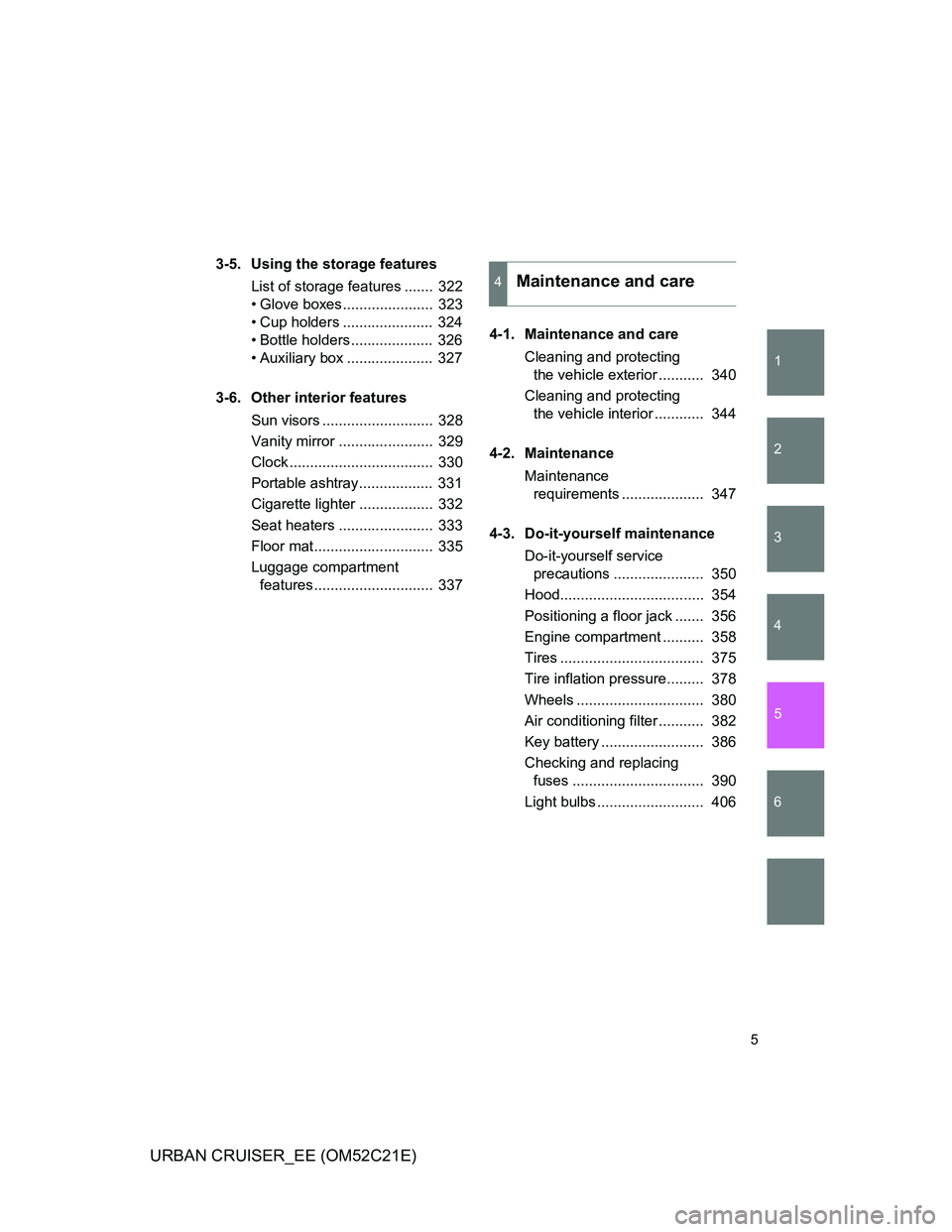
1
2
3
4
5
6
5
URBAN CRUISER_EE (OM52C21E)
3-5. Using the storage features
List of storage features ....... 322
• Glove boxes...................... 323
• Cup holders ...................... 324
• Bottle holders.................... 326
• Auxiliary box ..................... 327
3-6. Other interior features
Sun visors ........................... 328
Vanity mirror ....................... 329
Clock ................................... 330
Portable ashtray.................. 331
Cigarette lighter .................. 332
Seat heaters ....................... 333
Floor mat............................. 335
Luggage compartment
features............................. 3374-1. Maintenance and care
Cleaning and protecting
the vehicle exterior ........... 340
Cleaning and protecting
the vehicle interior ............ 344
4-2. Maintenance
Maintenance
requirements .................... 347
4-3. Do-it-yourself maintenance
Do-it-yourself service
precautions ...................... 350
Hood................................... 354
Positioning a floor jack ....... 356
Engine compartment .......... 358
Tires ................................... 375
Tire inflation pressure......... 378
Wheels ............................... 380
Air conditioning filter ........... 382
Key battery ......................... 386
Checking and replacing
fuses ................................ 390
Light bulbs .......................... 406
4Maintenance and care
Page 9 of 532
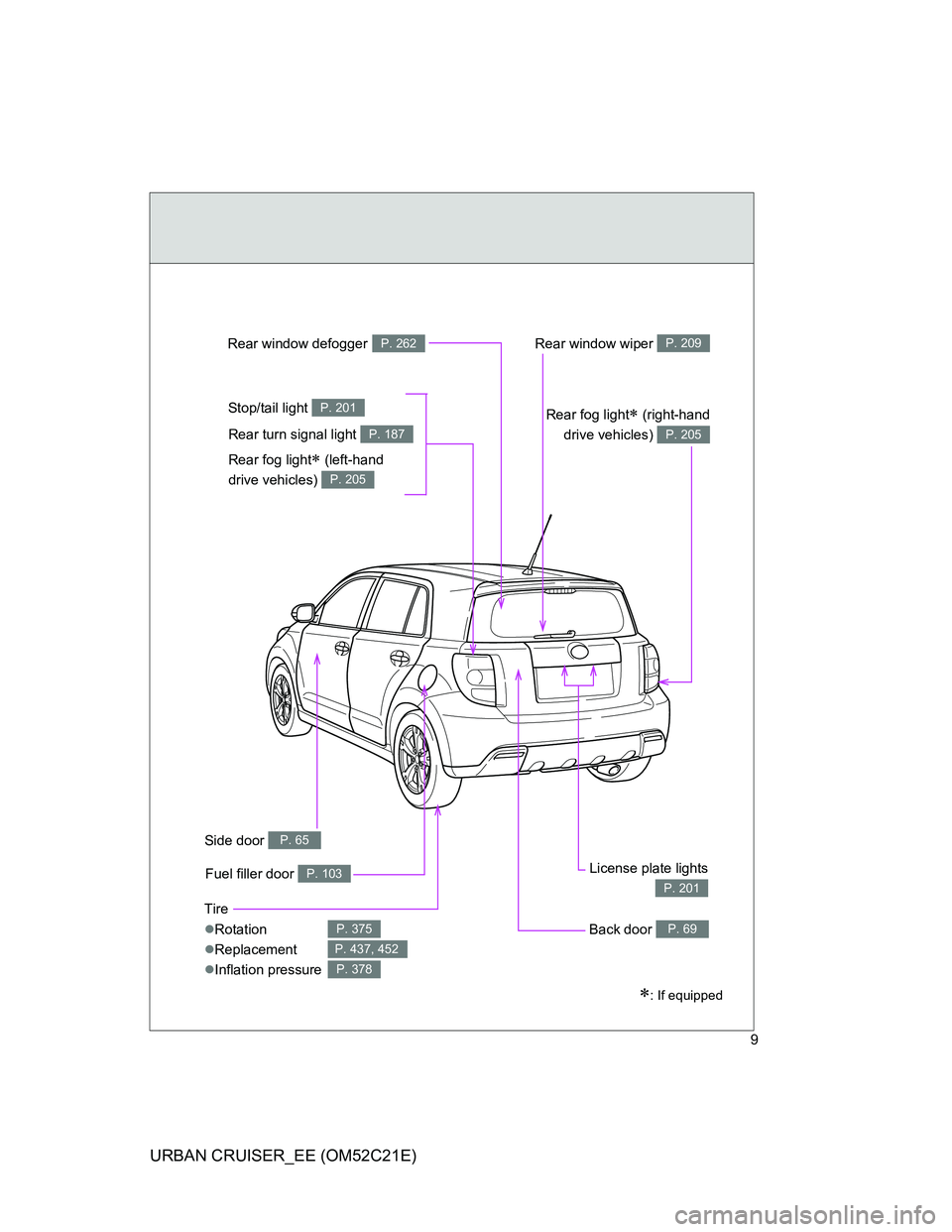
9
URBAN CRUISER_EE (OM52C21E)
Tire
Rotation
Replacement
Inflation pressure
P. 375
P. 437, 452
P. 378
: If equipped
Back door P. 69
Side door P. 65
Fuel filler door P. 103
Rear turn signal light P. 187
Rear window wiper P. 209Rear window defoggerP. 262
License plate lights
P. 201
Rear fog light (left-hand
drive vehicles)
P. 205
Stop/tail light P. 201Rear fog light (right-hand
drive vehicles)
P. 205
Page 222 of 532
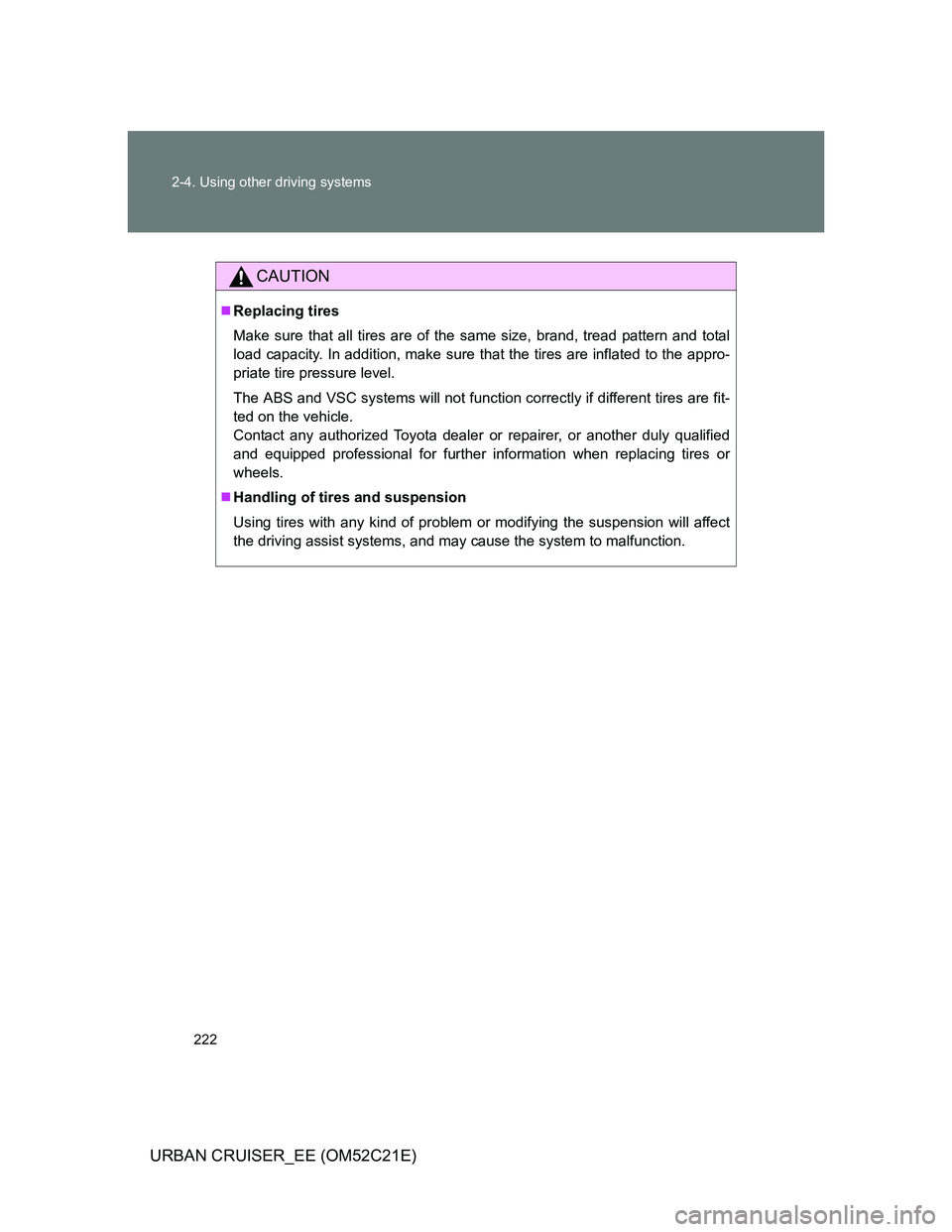
222 2-4. Using other driving systems
URBAN CRUISER_EE (OM52C21E)
CAUTION
Replacing tires
Make sure that all tires are of the same size, brand, tread pattern and total
load capacity. In addition, make sure that the tires are inflated to the appro-
priate tire pressure level.
The ABS and VSC systems will not function correctly if different tires are fit-
ted on the vehicle.
Contact any authorized Toyota dealer or repairer, or another duly qualified
and equipped professional for further information when replacing tires or
wheels.
Handling of tires and suspension
Using tires with any kind of problem or modifying the suspension will affect
the driving assist systems, and may cause the system to malfunction.
Page 230 of 532
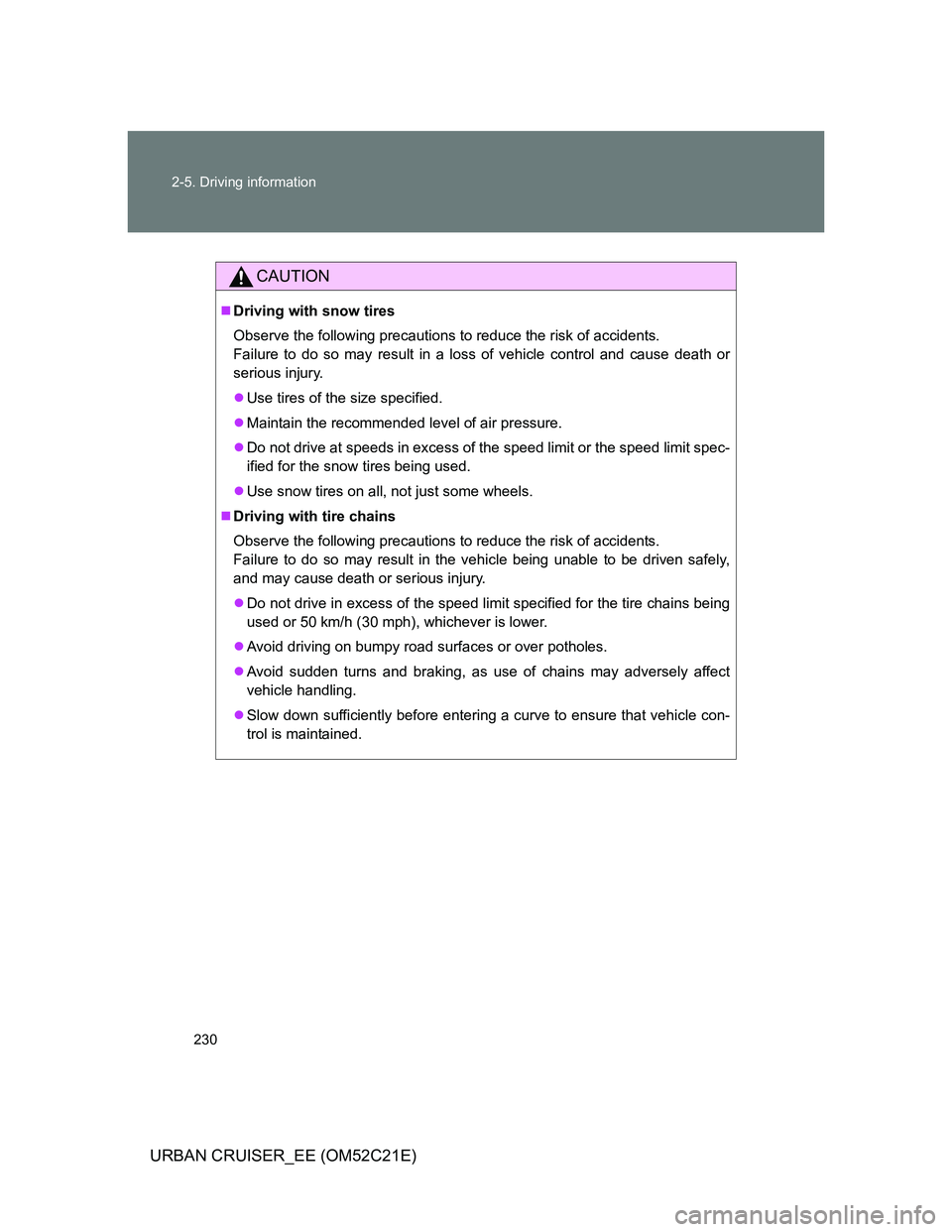
230 2-5. Driving information
URBAN CRUISER_EE (OM52C21E)
CAUTION
Driving with snow tires
Observe the following precautions to reduce the risk of accidents.
Failure to do so may result in a loss of vehicle control and cause death or
serious injury.
Use tires of the size specified.
Maintain the recommended level of air pressure.
Do not drive at speeds in excess of the speed limit or the speed limit spec-
ified for the snow tires being used.
Use snow tires on all, not just some wheels.
Driving with tire chains
Observe the following precautions to reduce the risk of accidents.
Failure to do so may result in the vehicle being unable to be driven safely,
and may cause death or serious injury.
Do not drive in excess of the speed limit specified for the tire chains being
used or 50 km/h (30 mph), whichever is lower.
Avoid driving on bumpy road surfaces or over potholes.
Avoid sudden turns and braking, as use of chains may adversely affect
vehicle handling.
Slow down sufficiently before entering a curve to ensure that vehicle con-
trol is maintained.
Page 236 of 532
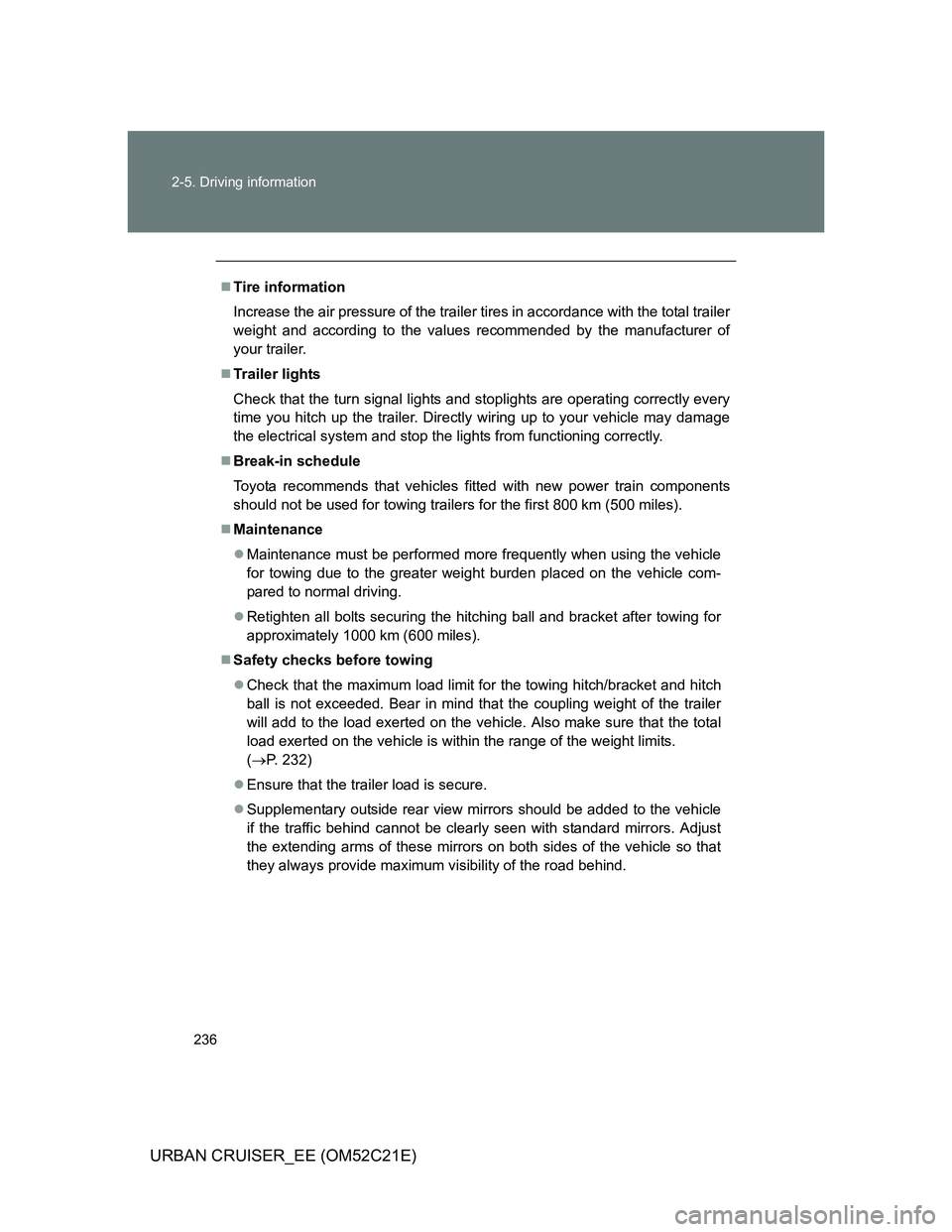
236 2-5. Driving information
URBAN CRUISER_EE (OM52C21E)
Tire information
Increase the air pressure of the trailer tires in accordance with the total trailer
weight and according to the values recommended by the manufacturer of
your trailer.
Trailer lights
Check that the turn signal lights and stoplights are operating correctly every
time you hitch up the trailer. Directly wiring up to your vehicle may damage
the electrical system and stop the lights from functioning correctly.
Break-in schedule
Toyota recommends that vehicles fitted with new power train components
should not be used for towing trailers for the first 800 km (500 miles).
Maintenance
Maintenance must be performed more frequently when using the vehicle
for towing due to the greater weight burden placed on the vehicle com-
pared to normal driving.
Retighten all bolts securing the hitching ball and bracket after towing for
approximately 1000 km (600 miles).
Safety checks before towing
Check that the maximum load limit for the towing hitch/bracket and hitch
ball is not exceeded. Bear in mind that the coupling weight of the trailer
will add to the load exerted on the vehicle. Also make sure that the total
load exerted on the vehicle is within the range of the weight limits.
(P. 232)
Ensure that the trailer load is secure.
Supplementary outside rear view mirrors should be added to the vehicle
if the traffic behind cannot be clearly seen with standard mirrors. Adjust
the extending arms of these mirrors on both sides of the vehicle so that
they always provide maximum visibility of the road behind.
Page 339 of 532
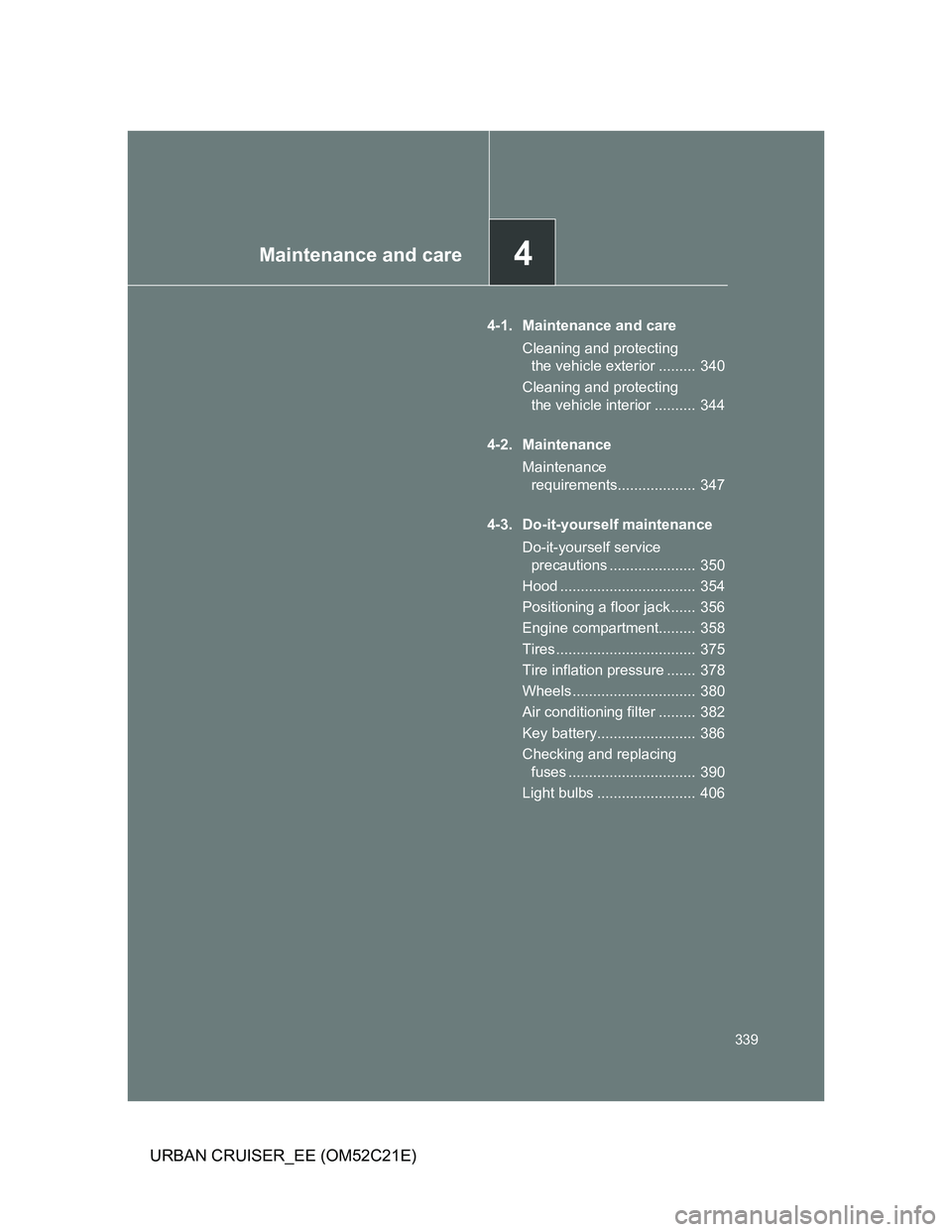
4Maintenance and care
339
URBAN CRUISER_EE (OM52C21E)
4-1. Maintenance and care
Cleaning and protecting
the vehicle exterior ......... 340
Cleaning and protecting
the vehicle interior .......... 344
4-2. Maintenance
Maintenance
requirements................... 347
4-3. Do-it-yourself maintenance
Do-it-yourself service
precautions ..................... 350
Hood ................................. 354
Positioning a floor jack ...... 356
Engine compartment......... 358
Tires .................................. 375
Tire inflation pressure ....... 378
Wheels .............................. 380
Air conditioning filter ......... 382
Key battery........................ 386
Checking and replacing
fuses ............................... 390
Light bulbs ........................ 406
Page 351 of 532
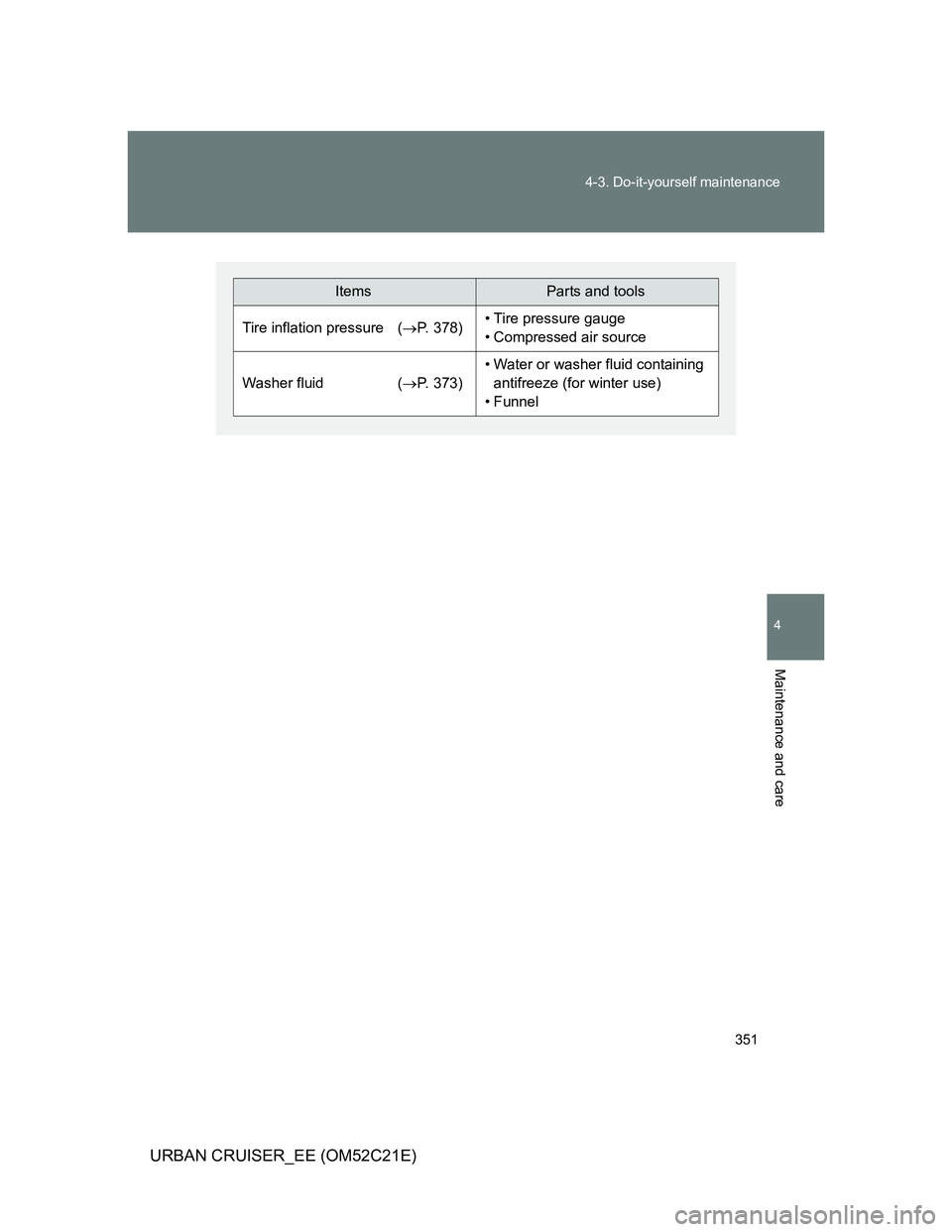
351 4-3. Do-it-yourself maintenance
4
Maintenance and care
URBAN CRUISER_EE (OM52C21E)
ItemsParts and tools
Tire inflation pressure (P. 378)• Tire pressure gauge
• Compressed air source
Washer fluid (P. 373)
• Water or washer fluid containing
antifreeze (for winter use)
• Funnel
Page 375 of 532
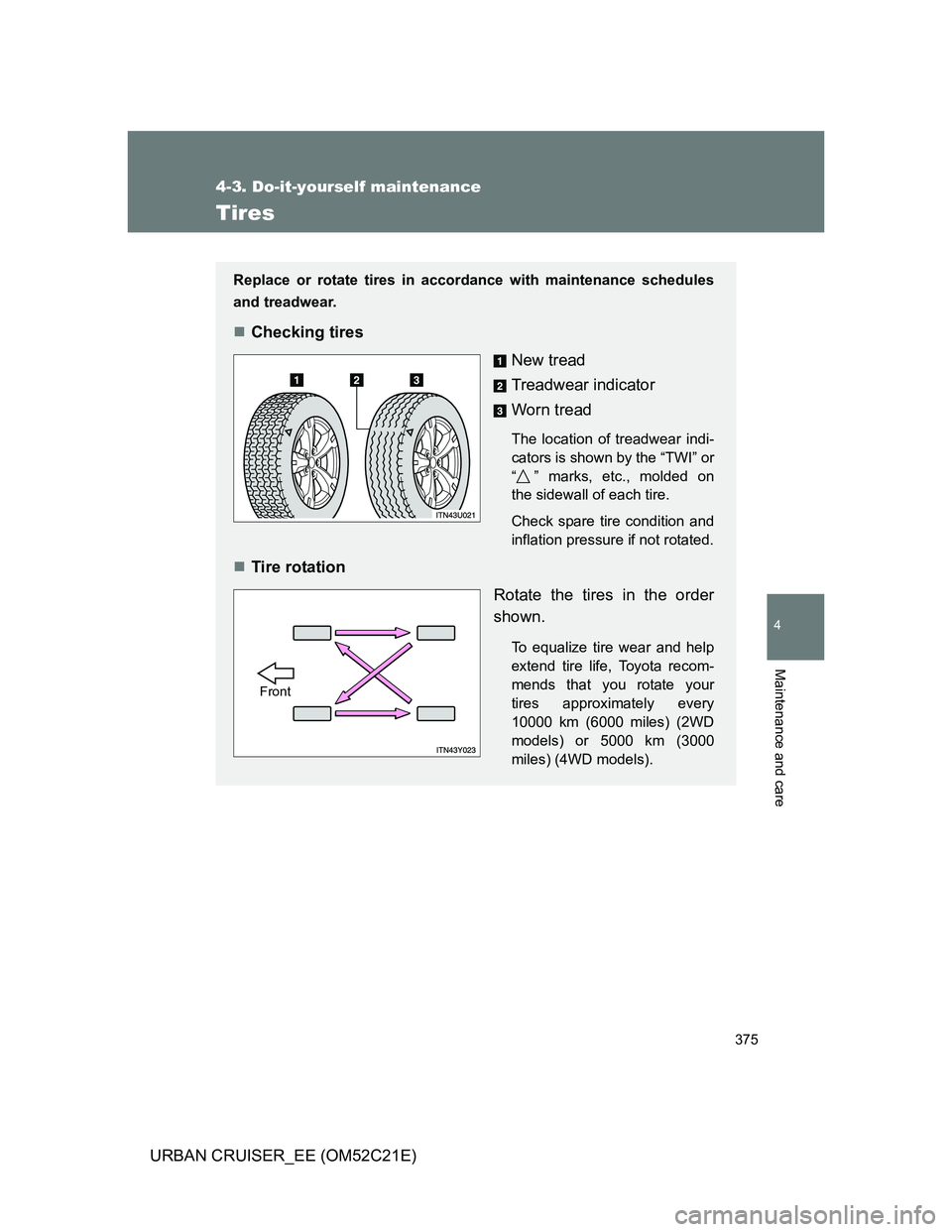
375
4-3. Do-it-yourself maintenance
4
Maintenance and care
URBAN CRUISER_EE (OM52C21E)
Tires
Replace or rotate tires in accordance with maintenance schedules
and treadwear.
Checking tires
New tread
Treadwear indicator
Worn tread
The location of treadwear indi-
cators is shown by the “TWI” or
“ ” marks, etc., molded on
the sidewall of each tire.
Check spare tire condition and
inflation pressure if not rotated.
Tire rotation
Rotate the tires in the order
shown.
To equalize tire wear and help
extend tire life, Toyota recom-
mends that you rotate your
tires approximately every
10000 km (6000 miles) (2WD
models) or 5000 km (3000
miles) (4WD models).
Front
Page 377 of 532
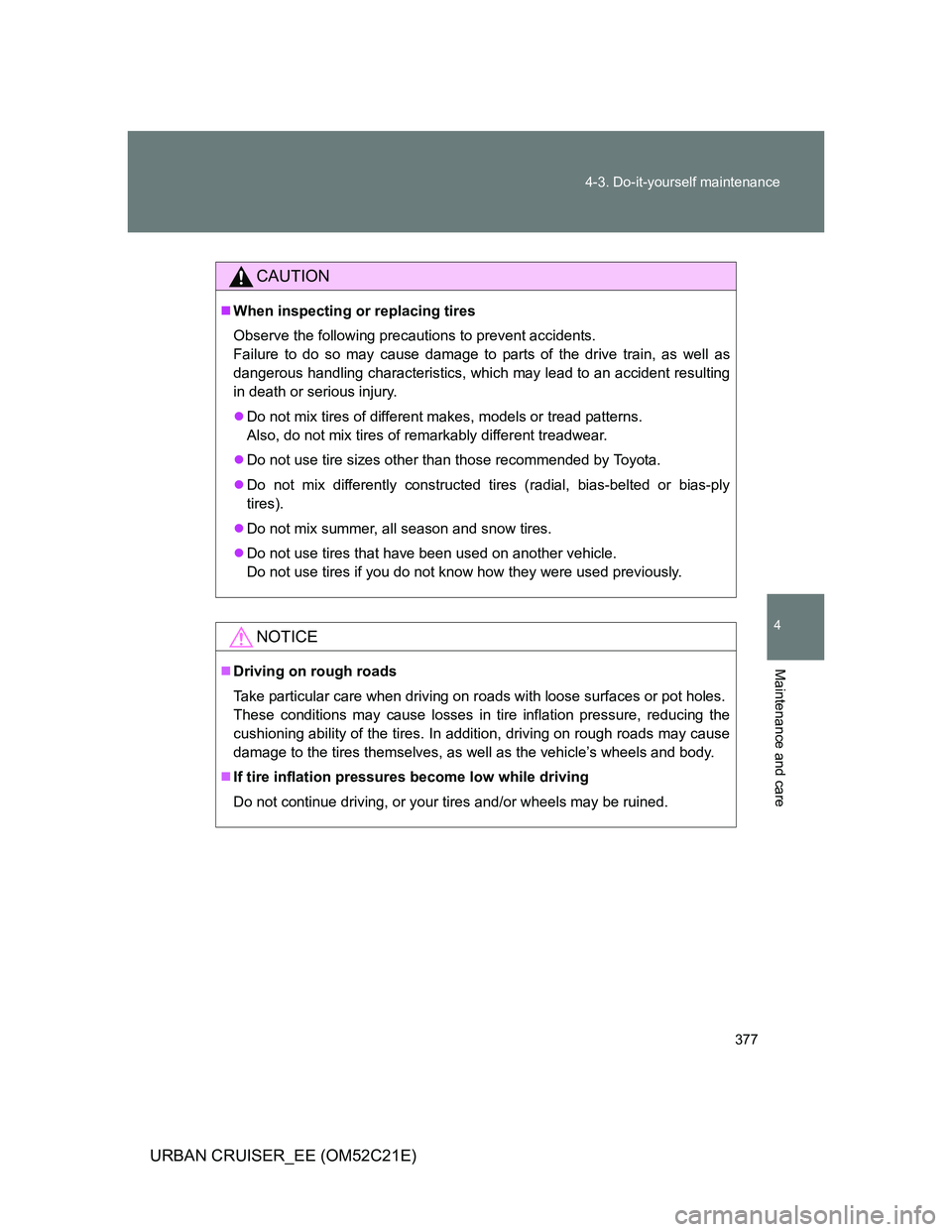
377 4-3. Do-it-yourself maintenance
4
Maintenance and care
URBAN CRUISER_EE (OM52C21E)
CAUTION
When inspecting or replacing tires
Observe the following precautions to prevent accidents.
Failure to do so may cause damage to parts of the drive train, as well as
dangerous handling characteristics, which may lead to an accident resulting
in death or serious injury.
Do not mix tires of different makes, models or tread patterns.
Also, do not mix tires of remarkably different treadwear.
Do not use tire sizes other than those recommended by Toyota.
Do not mix differently constructed tires (radial, bias-belted or bias-ply
tires).
Do not mix summer, all season and snow tires.
Do not use tires that have been used on another vehicle.
Do not use tires if you do not know how they were used previously.
NOTICE
Driving on rough roads
Take particular care when driving on roads with loose surfaces or pot holes.
These conditions may cause losses in tire inflation pressure, reducing the
cushioning ability of the tires. In addition, driving on rough roads may cause
damage to the tires themselves, as well as the vehicle’s wheels and body.
If tire inflation pressures become low while driving
Do not continue driving, or your tires and/or wheels may be ruined.
Page 378 of 532
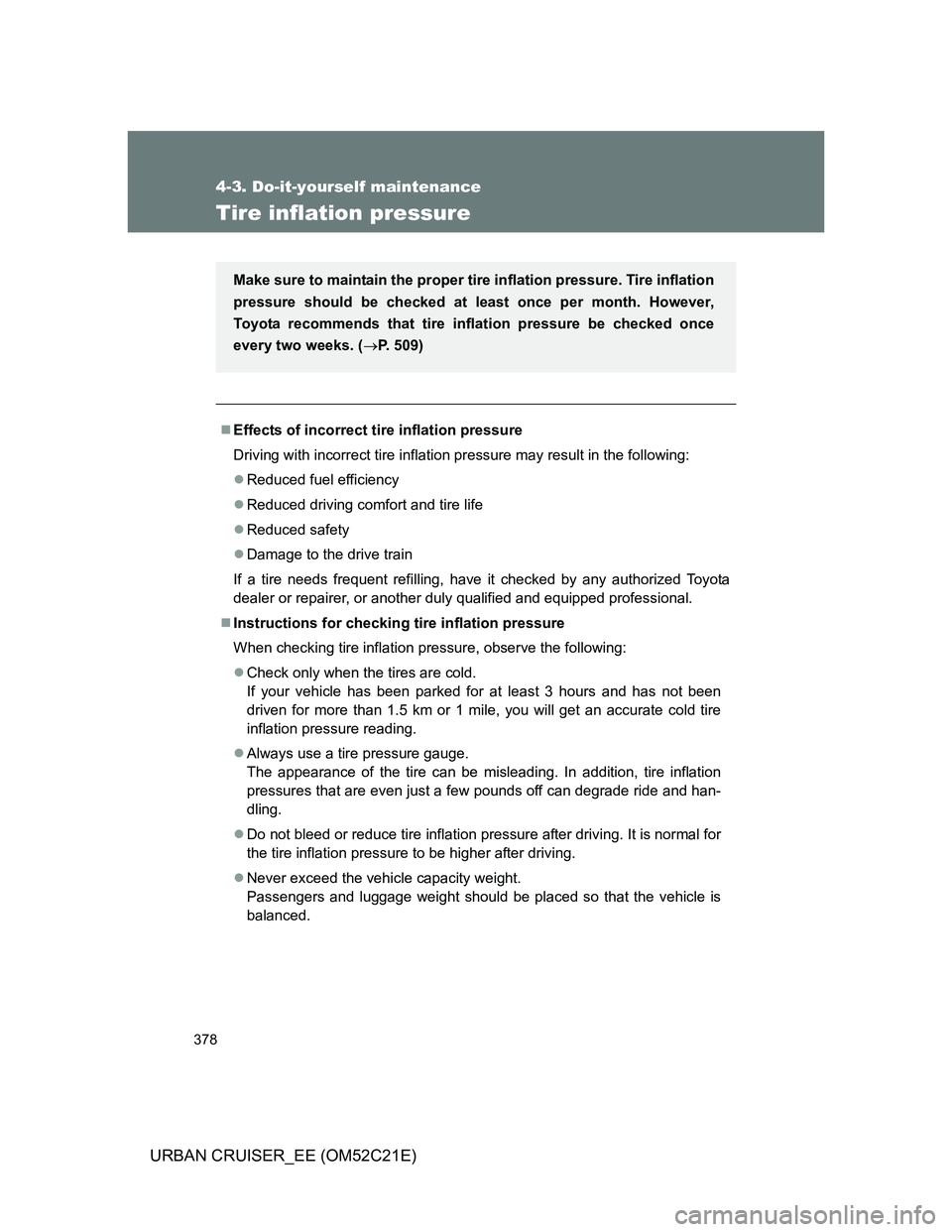
378
4-3. Do-it-yourself maintenance
URBAN CRUISER_EE (OM52C21E)
Tire inflation pressure
Effects of incorrect tire inflation pressure
Driving with incorrect tire inflation pressure may result in the following:
Reduced fuel efficiency
Reduced driving comfort and tire life
Reduced safety
Damage to the drive train
If a tire needs frequent refilling, have it checked by any authorized Toyota
dealer or repairer, or another duly qualified and equipped professional.
Instructions for checking tire inflation pressure
When checking tire inflation pressure, observe the following:
Check only when the tires are cold.
If your vehicle has been parked for at least 3 hours and has not been
driven for more than 1.5 km or 1 mile, you will get an accurate cold tire
inflation pressure reading.
Always use a tire pressure gauge.
The appearance of the tire can be misleading. In addition, tire inflation
pressures that are even just a few pounds off can degrade ride and han-
dling.
Do not bleed or reduce tire inflation pressure after driving. It is normal for
the tire inflation pressure to be higher after driving.
Never exceed the vehicle capacity weight.
Passengers and luggage weight should be placed so that the vehicle is
balanced.
Make sure to maintain the proper tire inflation pressure. Tire inflation
pressure should be checked at least once per month. However,
Toyota recommends that tire inflation pressure be checked once
every two weeks. (P. 509)